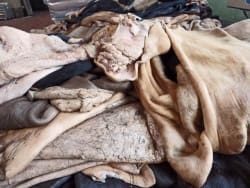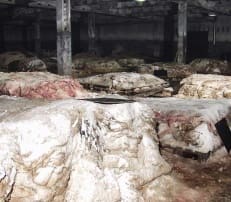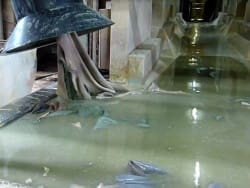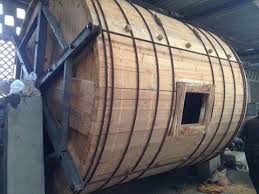Making leather is an extensive and technical process. In order for the process to produce a high-quality leather with the same finish each time, accuracy and care must be taken. The process will start with an animal hide and by the end of the journey there will be a piece of leather ready to be transformed into a bag, clothing or any other leather product. The modern commercial leather-making process involves three basic phases: preparation for tanning, tanning, and processing tanned leather. It generally takes 6-8 weeks to go through the entire process.
RAW MATERIAL
The most common hide used to make leather is from a cow. Though leather can also be made from the hide of almost any animal including pigs, sheep, goats and crocodiles. It is a by-product of the meat and dairy industries.

Good hide gives an 80-90% yield thus; the raising of the cow will affect the quality of the hide produced. For instance, cows that have been revealed to a lot of insect bites, kept near barbed wire fences or have had electric cattle prods used on them can have damage to their hide. Here the hide yield is more likely to be around 60% so as to avoid imperfection and holes. Even certain diets that include grains or growth hormones can make for a poorer quality hide.
As an introductory step, the skin must be carefully removed from the animal and then the flesh needs to be removed, which can be done by hand or by using fleshing machine. The process is important to be finished as quickly as possible if it is done by hand, since the material easily dries out. At the end of the process, clean white surface should remain. Now, the hide is protected both in storage and transportation before it reaches the tannery.
PRESERVATION

Salting
At this point a hide will begin to decompose within hours of an animal’s death to prevent this from happening, a dehydrating process is followed by either air-drying, wet or dry salting, or pickling with acids and salts before being shipped to a tannery. the hide may become useless and be wasted if it is not salted or frozen within the few hours of being removed. This hide will remain salted, until ready for the next process.
SOAKING
Now, these salted hides or skins are soaked water for several hours to several days to remove all water-soluble materials such as salt and dirt and restore it to its original shape and softness. This process allows to reabsorb the water that is lost in salting process or during transportation.
LIMING

The hair on hide needs to be removed, therefore the hair loosened by the process called liming, where it is soaked in the mixture of lime and water or in the chemical solution that contains calcium oxide for one or two days. This process will also soften the hide and would make it swell to around 4mm thick and can be cut into two layers.
UNHAIRING
The hair is removed from the hide.
FLESHING
Here the hide is passed through a machine to remove extraneous flesh. Hides may be separated into layers at this stage so that it can be used for different types of leather products. The upper part of the hide is used for highest quality leather products such as full grain leather because it has tighter fibre structure. And the bottom layer is used for cheaper leather because it has less quality than the top layer. These tend to be used for top grain and split leathers and are most commonly used for shoes and bags.
DELIMING
The principal action of deliming is to gradually neutralise the alkali in the pelt, avoiding rapid changes in pH which could lead to distortion or disruption of the tissues.
BATING
A long delime can significantly improve the removal of any remaining lime, scud and residual components broken down during liming. Bating – based on the use of enzymes – completes this process so that the pelt is flat, relaxed, clean and ready for pickling and tanning.
PICKLING
Weak acid and salt solutions are used to bring the pelt to the weakly acid state required for most tanning processes. Stronger pickling solutions are used to preserve pelts so that they can be stored or transported in a stable form over periods of several months.
DEGREASING
Solvents or water-based systems can be used to remove excess grease such as natural fats/oils from the hide before tanning.
TANNING

Tanning process converts the protein of the hides into a stable material through preserving the hide and halting decomposition. The tanning process converts the hard inflexible material into flexible form. There are different types of tanning methods and materials the type of process depends upon the end application of the leather. The most commonly used tanning material is chromium, which leaves the leather, once tanned, a pale blue colour (due to the chromium), this product is commonly called “wet blue”.
Along with a special tanning solution the hides need to be stuffed into a special tanning drum. This drum will contain a special mix of either a chromium salt mix or a vegetable tanning agents. Vegetable tanning is the oldest tanning methods. In general, a vegetable tanning mix, contains tannin extracts which is naturally found in tree barks, roots, leaves and seed husks which will produce a leather that is flexible and is generally used for luggage or furniture. The various vegetable tanning procedures can take weeks or months to complete.
Chromium salts produce a more stretchable leather so will be typically used on products like clothing or handbags. To obtain a fuller bodied leather that is both soft and supple, Tannage can also be combined with both vegetable and chromium salts. In order to make the leather both stronger and softer at the end of this process, special fats are added to the leather which is called a liquoring process. In this process, the hides are allowed to soak and the tanning liquor slowly penetrates through the full substance of the hide. Regular checks will be made to see the penetration by cutting the cross section of a hide and observing the degree of penetration. Once an even degree of penetration is observed, the pH of the float is slowly raised in a process called basification. This basification process fixes the tanning material to the leather, and the more tanning material fixed, the higher the hydrothermal stability and increased shrinkage temperature resistance of the leather The end result is a firm water-resistant leather.
After the primary tanning process is completed, the pelts are ready for processing, the final phase in leather production. the excess moisture needs to be removed so the pelt is first thoroughly dried. After the drying process, the hides can then be examined and arranged in levels of quality. The grades of leather will determine what that hide will be used for in future. Hides that have been treated with chromium salts will appear pale blue in colour.
RE-TANNING
The next stage, re-tanning process can occur again in order to get the leather fully ready for its intended purpose. This process is all about giving the leather the ‘character’ one desire. During re-tanning, you can change the look, feel, fullness, weight and color of the leather to add the characteristics that make a particular bag, jacket, car seat or other end product stand out in the marketplace. This will be a repeat using either the vegetable mix or with the chromium salts (or a combination) and the excess moisture is again removed using pressure.
Once the tanning process is complete the hides need to be dried. This drying can occur with a variety of processes such as air dried or vacuum dried. Air drying a hide involves putting a hide on something like an overhead conveyor where it will be rotated until completely dried. Vacuum drying is a quick method of drying, obtained by removing all the air from around the hide. This method will cause the hide to shrink slightly but will leave the hide with a smooth and tight texture.
During the re-tanning stage a bleaching agent can be used and this provides an excellent base to start the leather dyeing stage.
DYEING
 In meeting fashion requirements, the dyeing process of leather into a wide variety of colours plays an important part. This can be anything from the browns and blacks associated with leather to bright, bold colours. common methods of dyeing include drum dyeing, spraying, brush dyeing, and staining. Blended oils and greases are then incorporated into the leather to lubricate it and to enhance its softness, strength, and ability to shed water.
In meeting fashion requirements, the dyeing process of leather into a wide variety of colours plays an important part. This can be anything from the browns and blacks associated with leather to bright, bold colours. common methods of dyeing include drum dyeing, spraying, brush dyeing, and staining. Blended oils and greases are then incorporated into the leather to lubricate it and to enhance its softness, strength, and ability to shed water.
The most used process of dyeing is drum dyeing which can be incredibly lengthy with hides needing to be added to a large drum along with their chosen dye for a long period of time to ensure the dye takes. After around 8 hours a cutting should be taken to ensure that the dye has completely saturated the hide. Otherwise the leather will look patchy. Afterwards the leather needs to be rinsed thoroughly to remove any residual dye or chemicals. Once rinsed the hide should be dried entirely.
The leather is then dried to about 14 percent moisture, either in the air or in a drying tunnel or by first stretching the leather and then air or tunnel drying it. Other less frequently used methods include paste and vacuum drying. The dried leather is finished by reconditioning with damp sawdust to a uniform moisture content of 20 percent. It is then stretched and softened, and the grain surface is coated to give it additional resistance to abrasion, cracking, peeling, water, heat, and cold.
FINISHING
When the dyeing process is complete, the last stage in the leather-making is the finishing. This is the stage where the leather will be worked to ensure that it has the supple, flexible nature that is so desired in leather as well as the glossy finish. A finish that not only protects the surface but also one which can be easier to clean. This stage would be skipped if a naked leather was desired.
To soften the leather a machine called a staker is used where the leather is both stretched and lots of natural oils will be added to lubricate the fabric. This stretching motion also tightens the pore structure of the leather. This helps create a higher quality finish that is desirable to consumers.
The final touch is to apply a finishing spray on the leather. What the finishing spray is will depend on the desired finish of the leather. For instance, a coat of acrylic can be added for a patent leather finish, mother of pearl can be added to give a pearlescent finish and at this stage leather can be embossed with patterns. On a large scale production, the leather will be hung and moved through the chosen spray line before being put into an oven to be cured. Once finished the leather can be stacked to prevent the leather getting creased and then it can be sent off ready to be used in making leather products. Full grain leathers, however, will skip this stage as it’s not needed. Instead this leather will go through an ironing process, which will use varying degrees of pressure and heat until the desired sheen is obtained.
The last stage of the process will be a quality check to ensure the leather has the correct colour and that there are no tears or anomalies in the leather. From here the leather can be rolled and shipped ready to be turned into quality luggage, handbags or any other leather accessory.
Reference:
The Editors of Encyclopaedia Britannica. (2020, March 05). Leather. Retrieved June 23, 2020, from https://www.britannica.com/topic/leather
Leather production processes. (2020, March 19). Retrieved June 23, 2020, from https://en.wikipedia.org/wiki/Leather_production_processes
Stahl. (n.d.). How a leather product is made. Retrieved June 23, 2020, from https://www.stahl.com/leather/production-of-leather?gclid=CjwKCAjwrcH3BRApEiwAxjdPTePpQd7Na-nzHd4K8NCIMcXu3ZdMnwGCjjXVX7LQe09xXVI7U2Xk_hoC7_sQAvD_BwE
W-Fowler, A. (n.d.). How is leather made? Retrieved June 23, 2020, from http://www.all-about-leather.co.uk/what-is-leather/how-is-leather-made.htm
How is Leather Made? (n.d.). Retrieved June 23, 2020, from https://mahileather.com/blogs/news/how-is-leather-made

